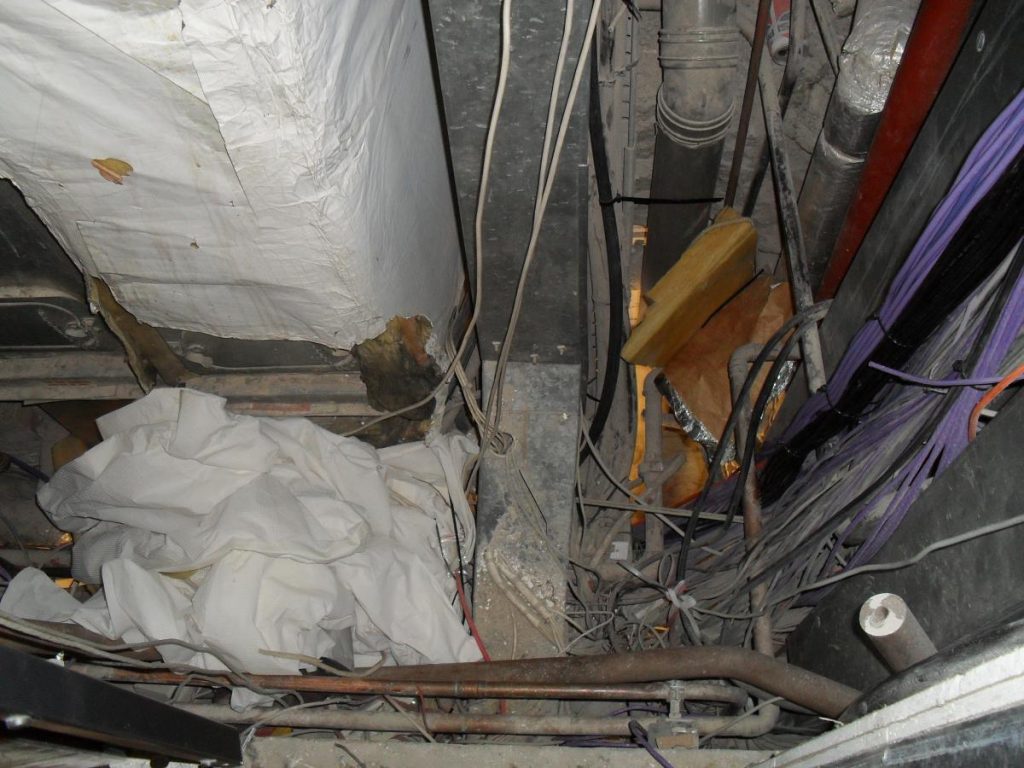The Fire Safety Order – is the knowledge gap closing?
The Fire Safety Order - is the knowledge gap closing?
Peter Barker, Senior Consultant at BM TRADA discusses the impact that the Regulatory Reform (Fire Safety) Order has had on the passive fire protection industry.
As an organisation responsible for fire testing and certification of construction products, BM TRADA receives many enquiries from various individuals and companies regarding passive fire protection within existing buildings. The queries are wide ranging but, since 2006, can nearly always be traced back to compliance with the Regulatory Reform (Fire Safety) Order (RRFSO).
What is clear from the types of enquiry is that there is currently a knowledge gap concerning passive fire protection. This is particularly apparent for individuals that have been tasked with responding to the findings of a fire risk assessment. It is certain that, despite the RR(FS)O having been in force for eight years, the number of queries related to passive fire protection that it generates has not abated.
One of the reasons why the RR(FS)O continues to raise questions with respect to passive fire protection is the general lack of building information available during the fire risk assessment process. Among other duties placed upon them by the RR(FS)O, the responsible person must conduct a suitable and sufficientrisk assessment (article 9) and take any general fire precautions, to ensure, so far as is reasonably practicable (article 8), the safety of relevant persons. The highlighted terms are subjective but are intended to allow risk-based solutions that are tailored to the building type, business undertaking and the occupants.
Built-in protection
Passive fire protection is the primary safety measure built into the fabric of a building. It helps to ensure the stability of the building and protect the means of escape in fire conditions. Unsurprisingly, therefore, it is one of the key aspects of a fire risk assessment. The difficulty for the fire risk assessor – whether they are the Responsible Person or have been nominated by the Responsible Person – is in ascertaining whether an element of passive fire protection has the required level of fire resistance to secure the means of escape. This assessment often has to be made in the absence of supporting test evidence and within buildings that pre-date current building regulations and design codes.

In the absence of information on the fire resistance properties and design of the building, the fire risk assessment can take various paths. These are normally a function of the competency of the risk assessor (see figure 1).
The examination of buildings during the fire risk assessment process has not only highlighted competency issues among those carrying out the assessments (Responsible Persons and professionals) but also within the building industry. To name just a few of the more common issues, many risk assessments find compartment lines breached by the installation of pipes and cables; deficient fire doors, which are poorly maintained; glazing incorrectly specified and installed; and poor fire stopping practices.
In fact, as some specialists operating in the passive fire protection industry have known for some time, the RR(FS)O has highlighted wide-ranging concerns including:
- A lack of information on buildings and the fire resistance performance of the products and systems that are installed.
- Fire-rated products and systems constructed incorrectly (non-compliant with test evidence or not tested).
- Fire-rated products and systems installed incorrectly (non-compliant with test evidence or not tested).
- Fire-rated products and systems are not maintained correctly.
- The passive fire protection systems installed within the building may not match the occupancy and use of the building, due to changes in building use and layout over time.
A great deal of construction work is directly or indirectly linked to passive fire protection and many of the more specialist systems are incorrectly installed or specified. Unfortunately, these mistakes are not always picked up in the building approvals process.
Inconsistent enforcement
The absence of building information is not the only issue that makes the risk assessor’s role challenging. The fire and rescue service is responsible for enforcing the RR(FS)O. Since inspections are subjective in their nature, this has led to inconsistent enforcement by different regions; and sometimes within the same fire and rescue service. What is deemed acceptable in the absence of supporting test evidence to some inspecting officers is not always acceptable to others. This has led to frustration for some Responsible Persons who view this as a shifting of the rules, making it even more difficult to comply.
As with any new legislation, there is a period of adjustment as businesses, enforcers and the law courts become familiar with the requirements and legal precedents are set. Judging by statistics released by the Department for Communities and Local Government (DCLG) for the period 2012-2013, there are still a large number of businesses that are either not aware of their legal obligations or choose to put profit before safety. The statistics for England showed that during this period 2,800 enforcement notices and 485 prohibition notices were issued and 58 prosecutions undertaken. Nevertheless, the RR(FS)O is slowly becoming accepted and understood as part of the landscape of fire safety legislation.
Driving improvement

During the last eight years, the RR(FS)O has highlighted a number of challenges related to our existing building stock. These are now being addressed in a number of ways:
- An increasing number of qualifications, training and certification schemes are being offered by UKAS-accredited certification bodies for individuals working with passive fire protection.
- There is increasing awareness and engagement in installing fire-resisting products that are manufactured by third party certificated companies. This not only provides confidence in the performance of a product but also assists with identification of the provenance of the product, which is useful for future maintenance and fire risk assessment.
- The Association for Specialist Fire Protection (ASFP) has produced the ASFP Guide to Inspecting Passive Fire Protection for Fire Risk Assessors, in order to communicate essential information regarding the passive fire protection systems that are incorporated within buildings. The guide places emphasis on prioritising assessment of the passive fire protection systems on the means of escape in order to evaluate what is needed for occupants to evacuate the building in the event of fire. The guidance is therefore intended to assist the Responsible Person in meeting the life safety objectives of the RR(FS)O. Fire risk assessments for insurance and property protection may need to consider the performance of passive fire protection systems that go beyond that required as a minimum for evacuation and life safety.
- The Fire Risk Assessment Competency Council was formed to develop competency criteria for fire risk assessors, thus providing benchmarks for individuals to choose a risk assessor with the appropriate level of knowledge for a particular building.
- There are a number of third party schemes and registers for fire risk assessors, again offering the end-user confidence in the competency of a fire risk assessor.
- The introduction of Primary Authority Schemes in 2014 aims to provide for more consistent and coordinated regulatory enforcement by local authorities and fire and rescue services.
- There is increasing awareness of Building Regulation 38, which requires that a package of fire safety information is handed over to the building owner when a building is complete. Aimed at ensuring that building owners have all the necessary information on the fire safety systems that are incorporated within the building, this regulation is not always complied with, despite having been in place since the RR(FS)O came into force. Access to this vital information, not only assists with the safe operation of a building on a day-to-day basis but is obviously valuable when it comes to undertaking a fire risk assessment under the RR(FS)O.
In summary, the RR(FS)O has had a huge and mainly positive impact on the passive fire protection industry, by highlighting competency issues at every level of the supply chain and revealing some of the fire safety concerns prevalent within our existing building stock.
This has raised the profile of passive fire protection and the industry has responded by introducing qualifications and benchmark standards for professionals working with passive fire protection. However, there is still a considerable amount of work to be done, to further improve understanding of the RR(FS)O and the role of passive fire protection, so that everyone is aware of their fire safety obligations. After all, compliance with the RR(FS)O isn’t just about avoiding fines and prosecution; it is about ensuring appropriate fire safety measures within buildings and the protection of life.

For further info contact: Peter Barker pbarker@bmtrada.com 01494 569 800 www.bmtradagroup.com
BM TRADA at Firex International
BM TRADA is to launch a new certification scheme at FIREX International on 17-19 June 2014, which aims to ensure that that fire stopping solutions are being fitted correctly and to verify the competence of installation companies, while offering building owners and Responsible Persons with a certificate of installation.
The Q-Mark Scheme for Fire Stopping Installation is designed to provide confidence to fire stopping installers that they are fitting products correctly; to building owners, specifiers and Responsible Persons that fire compartment lines have been properly sealed; and to fire stopping product manufacturers, that their products are being fitted correctly, in line with both their instructions and their fire test evidence.
BM TRADA will be launching the scheme from stand U800 at FIREX International 2014. The stand will feature videos which will demonstrate how correctly installed fire stopping can hold back the spread of fire and smoke, as well as showing the consequences of getting it wrong. Also on show will be a full size fire door which has been subjected to a fire test.
